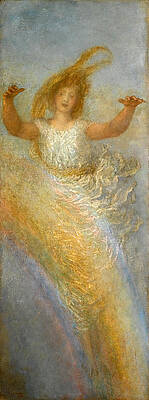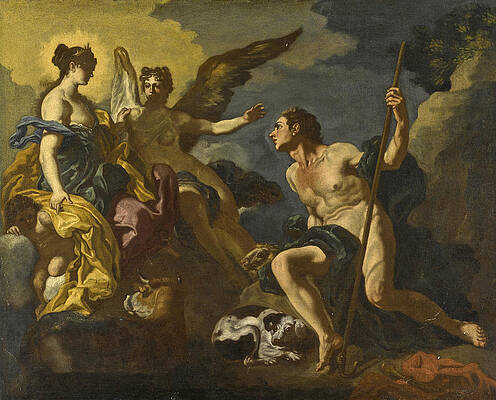.
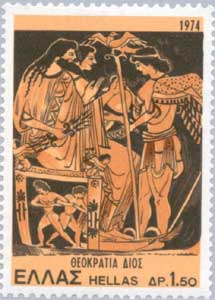
Zeus and Hera and the winged Iris
In Greek mythology, Iris (Ίρις) was the daughter of Thaumas and the ocean nymph Electra and one of the Oceanids (according to Hesiod), the personification of the rainbow and messenger of the gods. As the rainbow unites Earth and heaven, Iris is the messenger of the gods to men; in this capacity she is mentioned frequently in the Iliad, but never in the Odyssey, where Hermes takes her place.

Greco-Roman pantheon
Iris is frequently mentioned as a divine messenger in the Iliad which is attributed to Homer, but does not appear in the other work attributed to him, the Odyssey, where Hermes fills that role. Like Hermes, also known as Mercury, Iris carries a caduceus or winged staff. By command of Zeus, the king of the gods, she carries a ewer of water from the Styx, with which she puts to sleep all who perjure themselves. She is also represented as supplying the clouds with the water needed to deluge the world, consistent with her rainbow identity.
According to Apollonius Rhodius, Zetes and Calais who numbered amongst the Argonauts, delivered the prophet Phineas from the attentions of the tormenting Harpies. The Boreads' pursuit of the Harpies ended at the Strophades (`Islands of Turning'), where they were turned back, repelled by Iris. This eventful 'turning' may have resulted in the Islands' name.
They sent the winged heroes, the Boreads, after the harpies. They succeeded in driving the monsters away but did not kill them, as a request from the goddess of the rainbow, Iris, who promised that Phineas would not be bothered by the harpies again. It is said that the Boreads were turned back by Iris at the Strophades.[1] As thanks, Phineas told the Argonauts how to pass the Symplegades.
According to Hesiod's Theogony, Iris is the daughter of Thaumas and the ocean nymph Electra, an Oceanid. Her sisters are the Harpies, Aello and Ocypete. Iris is married to Zephyrus, who is the god of the west wind. Their son is Pothos (Nonnus, Dionysiaca). In some records she is a sororal twin to the Titaness Arkhe (arch), who flew out of the company of Olympian gods to join the Titans as their messenger goddess during the Titanomachy, making the two sisters enemy messenger goddesses. Iris was said to have golden wings, whereas Arkhe had iridescent ones. During the Titan War, Zeus tore Arkhe's iridescent wings from her and gave them as a gift to the Nereid Thetis at her wedding, who in turn gave them to her son, Achilles, who wore them on his feet. Achilles was sometimes known as podarkhes, or "wing-footed with Arkhe's wings". Not much is written about Iris' twin sister.
According to the Dionysiaca of Nonnos, Iris' brother is Hydaspes (book XXVI, lines 355-365).
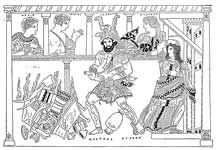
Heracles killing his children , Megara ,his wife, Iolaus and Alcmene as witnesses
In Euripides play Heracles Iris appears alongside Madness, cursing Heracles with the fit of madness in which he kills his three sons and his wife Megera.
Poetic titles and epithets: Chrysopteron (Golden Winged), Aellopos (storm footed), Podas ôkea (swift footed) or Podênemos ôkea (wind-swift footed), and Thaumantias or Thaumantos (Daughter of Thaumas, Wondrous One).
Iris, George Frederic Watts
Derivations and portrayals
- The word iridescence is derived in part from the name of this goddess.
- The 7 Iris asteroid is named after the messenger.
- "Arco iris" and "arco-íris" are the words for "rainbow" in Spanish and Portuguese, respectively.
- In 1946, Iris was depicted on a 50-franc airmail stamp in France. This was accompanied the same year by a 40-franc airmail stamp depicting a centaur shooting an arrow into the sky.
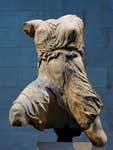
^ The Iliad, Book II, "And now Iris, fleet as the wind, was sent by Jove to tell the bad news among the Trojans."
Morpheus and Iris, Pierre-Narcisse Guerin
Juno accompanied by Iris gives Argus Charge of Io transformed into a Cow, Studio of Francesco Solimena
Morpheus Awakening as Iris Draws Near, Rene-Antoine Houasse
Stamps

Meteorology and Greek Mythology
See also
| Ancient Greece
Science, Technology , Medicine , Warfare, , Biographies , Life , Cities/Places/Maps , Arts , Literature , Philosophy ,Olympics, Mythology , History , Images Medieval Greece / Byzantine Empire Science, Technology, Arts, , Warfare , Literature, Biographies, Icons, History Modern Greece Cities, Islands, Regions, Fauna/Flora ,Biographies , History , Warfare, Science/Technology, Literature, Music , Arts , Film/Actors , Sport , Fashion --- |
Retrieved from "http://en.wikipedia.org"
All text is available under the terms of the GNU Free Documentation License

